- Date:2022-09-20
The Second Ward of Spine Surgery in Liaocheng Second People's Hospital is a key discipline in Liaocheng City. There are 20 medical staff, including 1 chief physician, 1 deputy chief physician and 2 postgraduates. It has domestic advanced medical equipment and minimally invasive spinal surgery technology.
Equipment: 1, Joimax intervertebral foraminoscope full set of equipment produced in Germany; 2, minimally invasive channel system instruments, which can carry out minimally invasive treatment of lumbar spondylolisthesis, lumbar intervertebral disc protrusion, spinal fracture under the channel; 3, surgical C-arm system.
Technology: The department takes ‘minimally invasive’ spine surgery as its speciality and establishes the concept of ‘stepped’ treatment.
1. Intervertebral canal implantation shock therapy: through the C-arm machine positioning in the intervertebral foramen nerve root site, the application of appropriate drugs to achieve the purpose of relieving clinical symptoms. It is suitable for diagnosis and confirmation of lumbar spine lesions, improvement of clinical symptoms of some elderly patients and critical patients (who cannot tolerate surgery).
2. Low-temperature plasma ablation technology: this technology adopts local anaesthesia under puncture technology, with low temperature safety, minimal trauma clinical characteristics. Cervical low temperature plasma radiofrequency ablation (myeloplasty) for cervical spondylosis is effective for sympathetic cervical spondylosis, which is mainly manifested by non-specific symptoms such as dizziness, tinnitus, panic attacks, neck and shoulder pain, etc. It is also effective for radiculopathic cervical spondylosis, which is mainly manifested by neck pain and pain and numbness in both upper limbs, etc. At the same time, it is also suitable for stubborn lumbar spondylosis. It is also suitable for the treatment of intractable low back pain. It avoids the risk and trauma of surgery and reduces the cost of patients. At present, this technique has been successfully carried out in our department and the patients have recovered well.
3. Joimax Intervertebral Foraminoscopy: mainly used for the treatment of lumbar disc herniation. The advantages of applying intervertebral foramoscopy to treat lumbar disc herniation are: the whole operation is completed under local anaesthesia, and the patient is awake throughout the whole process, which not only avoids the risk of anaesthesia, but also reduces the chance of nerve root damage; the operation directly removes the diseased disc, and treats the disease fundamentally. The patient's skin incision is about 0.7cm, with minimal trauma. No removal of the vertebral plate, no destruction of the paravertebral muscles and ligaments, less interference with the nerves and intravertebral structures, preservation of the epidural fat, reduction of intraoperative bleeding and postoperative formation of scar tissue in the spinal canal, and reduction of the likelihood of postoperative vertebral instability. The operation time is short, and the postoperative recovery is fast, with a general hospital stay of 5 days. For special patients, ‘day surgery’ can be carried out, i.e., the operation is carried out on the same day and the patient is discharged from the hospital on the same day. This shortens the hospitalisation time and reduces the economic burden of patients. At present, this technology has been routinely carried out in our department, and has been praised by the majority of patients.
4. Percutaneous vertebral kyphoplasty with high viscosity bone cement: Percutaneous vertebral kyphoplasty has become a standard procedure for the treatment of osteoporotic compression fractures and spinal metastases in the elderly. The use of high-viscosity bone cement further reduces the risk of cement spillage and pulmonary embolism. The technique uses puncture under local anaesthesia, which is low-risk and quick recovery. Patients can get out of bed and walk after the operation, avoiding the pain of prolonged bed rest, and are usually hospitalised for 3 days. The routine implementation of this technique has brought great social benefits, and the study has been included in the clinical topics of the Ministry of Health.
5. Minimally invasive spinal channel technology: the development of this technology has greatly broadened the application of minimally invasive technology in spinal disorders, which can be applied to lumbar spondylolysis, lumbar disc herniation accompanied by intervertebral instability, as well as thoracic and lumbar spine fracture treatment. It adopts a special channel for the spine to enter through the patient's normal intervertebral space (multifidus interspace) to carry out decompression, disc removal, bone grafting, combined with closed nailing technology to fix the patient's stage, which effectively avoids the destruction of the paraspinal muscles, ligaments, spinous processes and so on by the traditional surgery, and reduces the interference to the nerves and the structures in the vertebral canal, with little trauma, fast recovery and easy acceptance by the patients. At present, our department has routinely applied this technique to treat many thoracolumbar spine diseases with good results. At the same time, the routine development of this technology also marks the minimally invasive spinal surgery technology in our department has reached the advanced level in the province.
Cervical and lumbar pain has multiple causes: soft tissue origin, joint origin and disc origin. We can do step-by-step treatment, from conservative to minimally invasive, and from minimally invasive to open. Through the development of the above technologies, our department has gradually formed a ‘supermarket’ for the treatment of neck, low back and leg pain, and patients can choose the most suitable minimally invasive procedures for individualised treatment according to the characteristics of their own conditions, which has formed a greater influence in our city and the surrounding areas.
Third, the Department of Comprehensive Spine Treatment, which covers high-precision and difficult surgeries.
The department has routinely covered some serious cervical spondylosis, thoracic spinal stenosis, lumbar scoliosis deformity of the surgical treatment, postoperative rehabilitation exercise have achieved good therapeutic results.
Fourth, teaching and research has also achieved good results. She undertakes the clinical teaching tasks of Taishan Medical College and Binzhou Medical College. In recent years, the department has published one SCI paper, more than 10 papers in domestic core medical journals, edited or participated in writing four books, undertaken a number of municipal scientific research projects and has won the Liaocheng City Science and Technology Progress Award and Taishan Medical College Science and Technology Achievement Award.
The department has a medical team with excellent technology and unity and cooperation, working rigorously and conscientiously, taking patients as the root and quality as the core, treating each patient seriously.
Culture of the department: Heavenly reward for hard work.
Objective of the department: to adopt the simplest treatment to achieve the most ideal therapeutic effect.
Specialist Clinic:
Wang Chengjiang Chief Physician: All day Wednesday, All day Friday
Lin Xuelin, Deputy Chief Physician: All day Tuesday
Tel: 0635-2342591 0635-2342592
13506355130

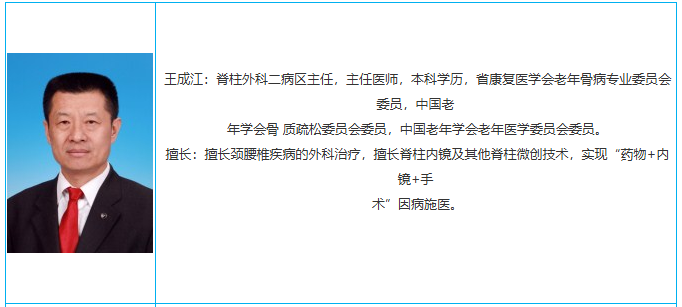
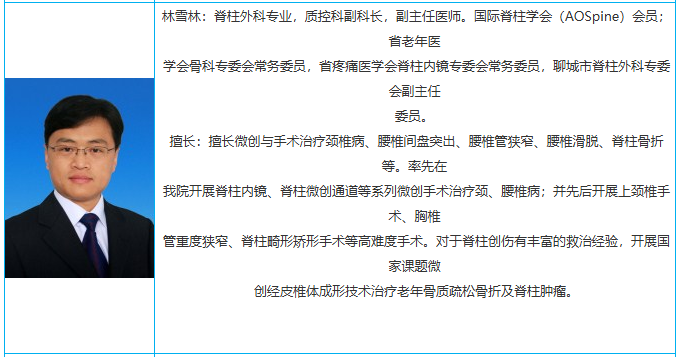
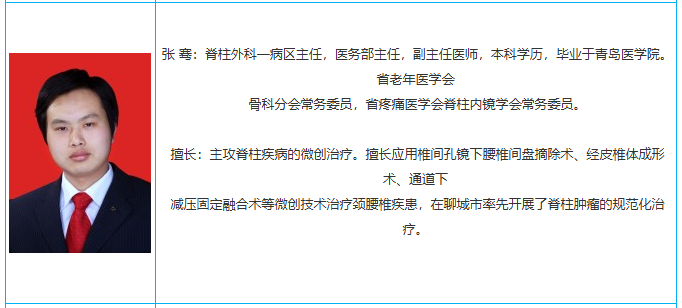
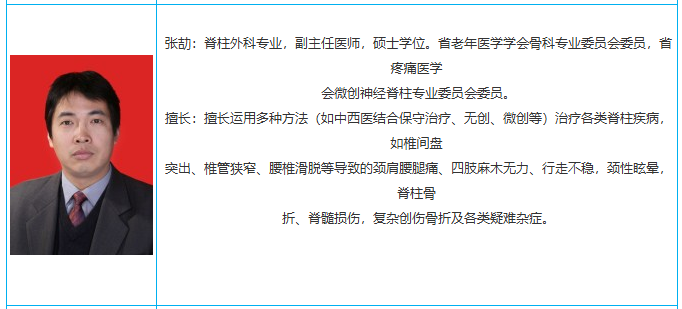
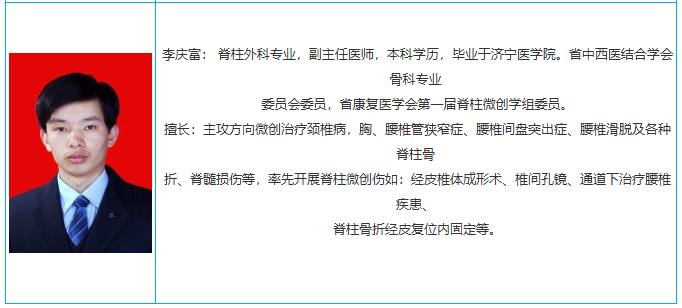


 鲁ICP备11009722号-4
鲁ICP备11009722号-4 